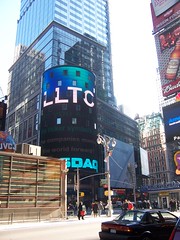| (Photo credit: Max Sparber) |
The employment report showed that the U.S. economy added 195,000 jobs in June, which beat analysts’ expectations of 165,000. The positive jobs numbers led analysts to expect the Fed to begin “tapering” of quantitative easing, and the bond market responded with a sharp selloff. The 10-year note jumped to 2.725%, the highest yield since August 2011.
At the close, the DJIA was up 147 points to 15136, the S&P 500 rose 16 to 1632, and the Nasdaq jumped 36 to 3,479. The NYSE traded 625 million shares, while the Nasdaq crossed 331 million. On the Big Board, advancers were barely ahead at 1.2-to-1; however, on the Nasdaq, advancers beat decliners by 2.8-to-1.
The dollar was strong vs. a basket of currencies, as was crude oil, because of the crisis in Egypt and the fear of a civil war and the possible closing of the Suez Canal. meanwhile, gold continued its march lower.
The Russell 2000 (small caps) broke from the resistance channel that has defined its range since its May 22 high at 1008. The break is accompanied by lower-than-average volume but supported by a buy signal from the MACD.
Unlike the lower-quality indices, the S&P 500 has failed to close above its bearish resistance line. However, on Friday, two bullish triggers were pulled — a close above the 50-day MA at 1626 and a buy signal from its MACD indicator.
Conclusion: Despite what appear to be very bullish charts for mid- and small-cap stocks, troubling signs are holding me back from a full bullish commitment. First, volume and breadth have been contracting; normally, major bullish breakouts occur with an increase in volume and breadth of at least 4-to-1 or 5-to-1. Secondly, and more troubling, is the enthusiasm for lower-quality stocks amid a huge increase in interest rates. This bullish enthusiasm is supported by a 12% jump in bullish sentiment in the AAII Sentiment Survey, which is a contraindicator.
Higher rates not only impact bond prices, which could be a short-term advantage for stocks, but are a disaster for the recently revived building industry — and a negative for the economy.
However, in the short run, traders should follow the trends and go for the fast-moving but volatile small caps, while longer-term investors should wait for a breakout of the more senior indices. Meanwhile, both types of investors should avoid “bond proxies” like utilities, REITs and other sectors that in the past year have appreciated as a result of high yields.
...





No comments:
Post a Comment